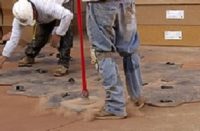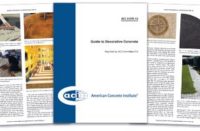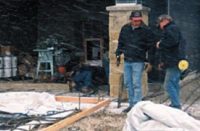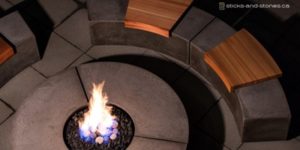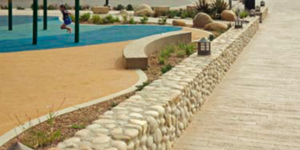ConScape Inc., a commercial, architectural and decorative concrete firm in Fort Worth, Texas, seemed like a godsend to the parishioners of a Catholic church in Keller, Texas. With decorative concrete as its intervention, the company transformed part of the church’s landscape from a tired terrain into a radiant and peaceful panorama.
“It was fairly barren out there,” says Steve Howe, facilities manager of St. Elizabeth Ann Seton Catholic Church. “We had dead grass, some scraggly trees, some of the top soil had washed away. We had an asphalt walkway for the Stations of the Cross,” a series of 12 artistic representations depicting Christ carrying the cross to his crucifixion.
The area — “a very holy space we wanted to make look better” — didn’t have any lighting at all. “It was extremely tacky looking,” Howe confesses.
Beautifying the garden
Thanks to ConScape, all that’s changed. To remember their loved ones and members who have passed away, church parishioners now have handsome columbariums, granite structures that hold cremated remains, and a beautiful concrete walkway that meanders through the landscaped and lit grounds of the East Garden.
Architect Scott Martsolf with Martsolf Architecture in Fort Worth specified stamped concrete with both integral color and color hardener as the prominent concrete feature for both the walkway and the bases of the four columbarium clusters. The circular bases feature a hub-and-spoke design.
“They had an existing asphalt walkway which connected the Stations of the Cross but they wanted something more permanent and more dressed up than what they had,” Martsolf recalls. “They wanted it to look a little more reverent to complement the classic style architecture they have on the rest of the campus.”
The asphalt walkway was replaced with concrete stamped with Yorkstone by Proline and colored with Concreation’s color hardener in Coquina and its antique release in Walnut. The new walk totals 7,650 square feet.
Laying the foundation
The project, completed in spring 2014, includes two clusters of seven columbariums resting on 900-square-foot circular concrete bases, with two additional bases in place for columbarium clusters in the future. Each cluster is designed to have seven units, each containing 484 niches for cremated remains.
To shape the pours for the 25-feet in diameter bases, ConScape used 2-foot-tall hardboard around the perimeters to create forms that could be used throughout the entire process. They lined these with carton forms, cardboard-box forms that measure 3 feet wide by 5 feet long and 10 inches thick.
“We placed the carton forms and then we encased them with grout concrete without aggregate to protect them from any kind of rain or moisture prior to the structural slab being placed on top,” says Ryan Halfmann, the project superintendent and part owner of ConScape.
“The forms create a void so if the dirt below them expands or contracts they don’t push up the slab. They eliminate any heave,” he says. Eventually, these cardboard forms disintegrate.
On top of the carton forms, they poured 2 inches of grout, followed by a 12-inch structural base and then a 4-inch decorative cap. “It’s kind of like a layer cake, with the 2-foot hardboard acting like the cake pan,” Halfmann says. “By using the hardboard, we only had to set one perimeter form for each base and leave it in place until the last of the pours was complete. Otherwise, we would have had to wreck forms after each pour, then raise the form to the next elevation.”
Heavenly results
Each circle, which contains planters for landscaping, took about 10 days to form and pour. The decorative tops were colored with color hardener and stamped with a seamless texture skin. Integrally colored contrasting bands were poured separately from the field areas. A 4-by-2-foot area of cobalt-black washed aggregate was incorporated into the circles’ design at the base of each granite columbarium.
The project was sealed with AS3000 manufactured by Artcrete. “Tony Wagoner, a church member who works for Concrete Design Center in Fort Worth, really helped us sort through sealers to find the right one to use,” says Halfmann.
Martsolf says the pathway and columbarium clusters connect with the larger landscape and to each other as well as the other classic and traditional buildings on campus. He adds that different colors and textures identify each cluster as a separate area.
“I think it turned out exactly as we wanted,” he says. “Something soft, classic and low maintenance. It’s a very beautiful campus with a medieval look.”
For Halfmann, the biggest challenge, believe it or not, he says, was the rebar. “The way the engineer designed the columbarium clusters meant that the weight of those (units) was not sitting directly on the piers below,” he says. “It was a complicated schematic. Reading the plans and figuring it out as we w
ent along was a bit like putting a puzzle together.”
Facilities manager Howe says he appreciates that the church finally has this beautiful area it had planned for and wanted for so long. “I love it,” he says. “It’s outstanding. It’s low maintenance and everything was very well thought out.”
“It was a really neat project for me because it’s my church,” says Halfmann. “Been going there 16 years. The team on the project really worked well together. It was a challenging project but a good project, and it worked out well.”
Project at a Glance
Client: St. Elizabeth Ann Seton Catholic Church, Fort Worth, Texas
Decorative concrete contractor: ConScape Inc., Hurst, Texas
Project superintendent: Ryan Halfmann, part owner of ConScape
General contractor: Shawn Moore, Scott Dennett Construction, Fort Worth | www.dennettconstruction.com
Architect: Scott Martsolf, Martsolf Architecture, Fort Worth, Texas | www.martsolfarch.com
Scope of project and products used: The project consisted of four, 900-square-foot concrete circles set on carton-form bases and integrally colored with Davis Colors. The columbarium platforms had 28 drilled piers and were stamped with a Proline Bluestone texture mat. A 7,650-square-foot walkway was stamped with Yorkstone by Proline and colored with Coquina and a Walnut release, both by Concreations (Aledo, Texas). The architect also incorporated a cobalt-black washed-aggregate finish for different textures along with the stamped concrete. Twelve-inch black bands, also stamped with the Bluestone texture mat, totaled 1,165 square feet. Fifteen steps were cast in place with integral color. Around the bases of the columbariums, there is 730 square feet of washed aggregate in black granite. The project was sealed with AS3000 manufactured by Artcrete.
